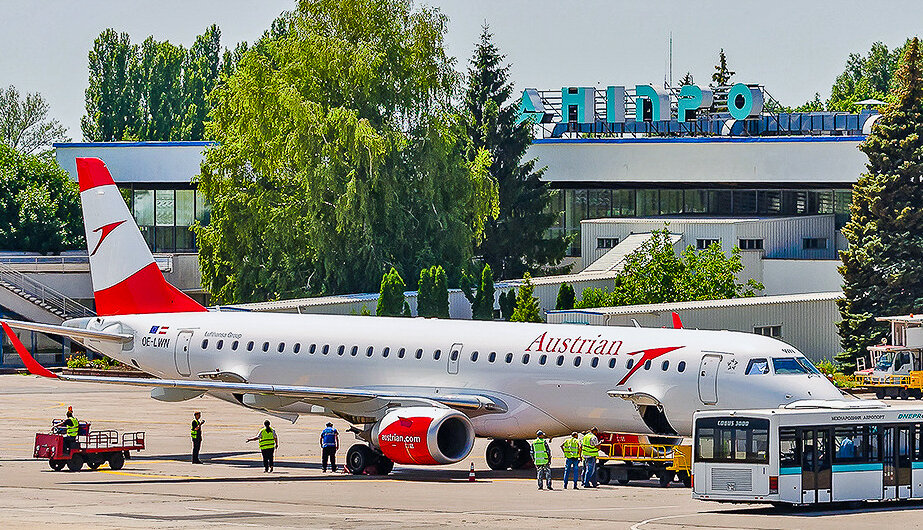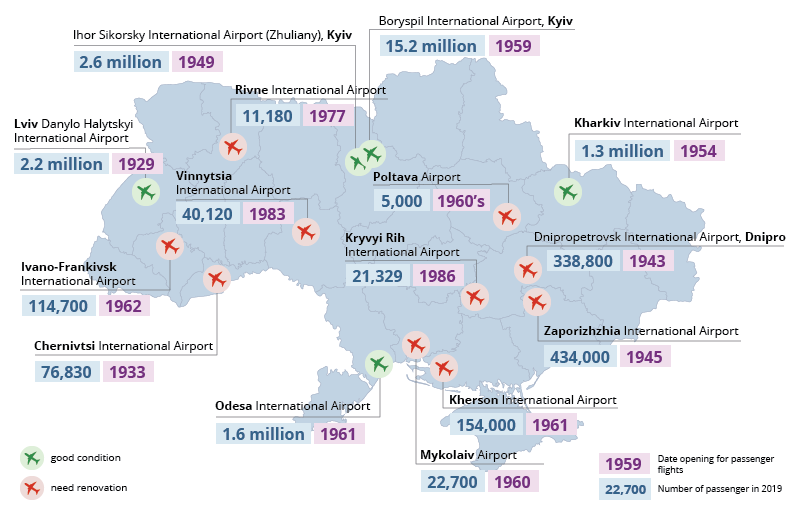When Ukraine stopped air traffic in March, regional airports were hit first.
After decades of neglect, the country’s local airports built in Soviet times were already vulnerable even before the pandemic. But when the state stopped international and domestic travel on March 17 to curb the spread of the novel coronavirus, regional airports began losing money due to the lack of passengers traveling throughout Ukraine and abroad.
The lack of money could eventually stop their renovations whatsoever and threaten their existence. Ultimately, this can result in Ukraine closing some regional airports due to a lack of money.
Moreover, travel restrictions have put a stop on their development, Maksym Panchenko, an analyst and journalist for who specializes in aviation, told the Kyiv Post. “They can hardly see any development in the midst of the pandemic.”
Neglected airports
The quarantine had a plummeting effect on reducing the number of flights operating from regional airports, Alina Pecheritsa, spokesperson at the Kharkiv airport, told the Kyiv Post.
She said passenger traffic was reduced by 53% since January in the Kharkiv airport, located in a city of 1.5 million people and 480 kilometers east of Kyiv.
The airport — renovated in 2012 for the Euro 2012 football championship — is one of the five most modern airports in the country, including Kyiv’s Boryspil and privately-owned Igor Sikorsky (Zhuliany), as well as Odesa and Lviv airports.
The 15 other airports operating in Ukraine are in dire need of funding as they are in physical decline. Passenger traffic has been their main source of income in order to keep up with the renovation of their mismanaged and neglected infrastructure: their runways are in careless conditions and some are too short for planes used by international companies such as Airbus or Boeing, according to analyst Panchenko.
“It is a common situation in regional Ukrainian airports,” he said.
Panchenko used the example of privately-owned Dnipro International Airport, near Dnipro, a city with a population of 1 million people, 480 kilometers southeast of Kyiv, the only major airport in the region — but also the most outdated.
Passengers often complain about the neglected airport and its outdated terminal while pilots complain about the alarming condition of the runway.
The airport’s location is also problematic: frequent fog provokes flight delays and can even cancel flights, according to Romain Desthieux, head of agriculture company MAS Seeds, and a frequent traveler.
Desthieux told the Kyiv Post that Dnipro was “the worst” airport he’s ever been to, comparing it to Arusha in Tanzania, a jungle airport where the runway is almost non-existent, but “without the good view on the Kilimandjaro.”
“The runway is the worst I’ve ever seen, bits of concrete come off the tarmac,” he said.
Long-running issues with the Dnipro airport are likely to stay the same, Volodymyr Omelyan, former minister of infrastructure told the Kyiv Post.
“I don’t see any serious development there,” Omelyan said, adding that the renovation dragged on for years due to mismanagement.
Petro Lypovenko, head of the Association of Ukraine of Civil Aviation which unites most of Ukraine’s airports under its wings, admitted that the Dnipro airport, created in 1943, has not developed since the 1980s.
Yet he said the state is willing to update the infrastructure. President Volodymyr Zelensky pledged to renovate it in July 2019, but the project drags on.
According to Omelyan, the government is wasting energy and money on endless renovations with no results and it leaves eastern Ukraine without access to any good airport infrastructure, he said.
Despite numerous attempts, the staff of the Dnipro airport did not answer to the Kyiv Post’s requests for comment.
According to Omelyan, the government is missing opportunities in developing other regional airports such as Odesa as it could help the struggling Ukrainian economy.

An Austrian Airlines stands in front of the terminal of the outdated Dnipro International Airport, near a city with a population of 1 million people, 480 kilometers southeast of Kyiv, the only major airport in the region of eastern Ukraine— but also the most neglected. (Dnipro Airport)
Forgotten areas
Regional airports could make a substantial contribution to Ukraine’s economy as airports directly affect the economic growth of regions, according to Lypovenko. If a region has an operating airport, it draws the attention of investors as travel and flights become more convenient, he said.
Pecheritsa said that the wider the network of airports the easier it is to attract investments and tourists to eastern Ukraine, a region of the country which substantially lacks modern infrastructure.
If Ukraine does not heavily invest in its airports, the country will not be able to put up with big hubs such as Turkey and Poland. Ultimately, this means that the country will lose on additional international routes that bring more passenger traffic to its airports, hence more money to renovate outdated infrastructure and to bolster the regional economies.
When Poland finishes its giant 3,000-square-meter air travel hub in Warsaw, which promises to serve up to 100 million passengers a year when it opens in 2027, Ukraine may never become an important hub in the region, Omelyan said.
“If we don’t do something, we will become a regional country,” he said.
However, Omelyan’s idea to multiply domestic and international travels in Ukraine through regional airports is still in the plans of Vladyslav Kryklii, incumbent infrastructure minister and Omelyan’s successor.
Following his predecessor’s program launched in 2018 to develop 50 modern airports in the country by 2030, Kryklii said three key airports near Ukraine’s borders are on the list: Mukachevo to the west, Izmail to the south, and Berdyansk to the east.
An airport in Mukachevo, a city of 82,000, close to Hungary and Slovakia, and 770 kilometers west of Kyiv, has to be built from scratch.
In the south, the Izmail airport, a small municipal airport, near a town with 72,500 residents and 720 kilometers southeast of Kyiv, is another promising option but its runway and terminal have been in ruin since it closed 10 years ago.
As for eastern Ukraine, Berdyansk, a city of 113,000 people near the Azov Sea, could be back on the map as well if the government finds enough investments to renovate the airfield, closed since 1987.
However, the question remains: How to finance such operations in the midst of a global aviation crisis?

The map shows Ukraine’s airports, the date when they opened to commercial flights, and their passenger traffic in 2019. Ukaine’s central airports are in Kyiv, Lviv, Kharkiv and Odesa. Kyiv’s Boryspil International Airport is the busiest, 65% of all passengers in Ukraine use this airport. These airports are in good condition due to recent renovations, but the rest of the regional airports need large-scale renovations to operate properly. In all, there are 20 airports in Ukraine. The map doesn’t include airports in Ternopil, Sumy, Uzhhorod, Cherkasy, and Zhytomyr. (Kyiv Post/ Alina Sedlerova)
Finding money
Aviation suffers around the world due to travel restrictions, yet Ukraine’s regional airports are far from the list of top priorities for state-funding.
According to Alexandre de Juniac, CEO of the trade association International Air Transport Aviation, 2020 will be a catastrophic year for aviation globally, with the industry losing over $80 billion.
“Financially, 2020 will go down as the worst year in the history of aviation,” De Juniac said.
Omelyan echoed this statement. Airports are obliged to take loans from commercial banks to pay their employees, he said, and they are forced to lay off employees to survive, like at the privately-owned Igor Sikorsky Kyiv International Airport, the second largest airport in Kyiv, which on June 30 laid off half of its staff, or 1,000 employees.
Vasyl Khmelnytsky, the founder of the UFuture holding company and owner of the airport, told the Kyiv Post that, despite Zhuliany being the second biggest airport of the capital, it is struggling.
“We do not receive support from the state,” Khmelnytsky said.
He invested more than Hr 630 million ($22.7 million) from his pocket in a new terminal, while state-owned Boryspil uses subsidies, and budget money to stay afloat, Khmelnytsky said.
But in times of crisis, the money is lacking, and the Ministry of Infrastructure does not have enough funds to help every airport, according to Omelyan.
Streamlining taxes could be an option to get the funding, as suggested by the management of the country’s largest airline, Ukraine International Airlines (UIA). The company offered to use a newly introduced $2 tax on each passenger for regional airports, media Ukrainian News reported, citing UIA.
But Omelyan, who launched the Road Fund in 2018, dismissed the idea. He said roads and airports need different financing, another strategy.
“We don’t need a special fund, we need special financing,” he said, but didn’t specify the difference.

The Odesa Airport’s main terminal was renovated in 2012. Its location near the Black Sea makes it a key asset in the region, but it still needs to modernize its runway and another terminal to work at full capacity. (Odesa Airport/Facebook)
Short-term profit
There are other solutions such as reaching out to foreign investors to encourage them to develop regional airports through concessions and public-private partnerships, Lypovenko said.
Concessions are public-private partnerships, where a state transfers an airport to a private investor and the investor renovates the airport in exchange for profits from its operations.
“We consider every option,” Lypovenko said.
The state needs at least $575 million to modernize its regional airports, according to Lypovenko. Opening the airports to private enterprises would help get at least part of it, he said.
For that, Minister Kryklii announced on Feb. 3 that French company Vinci Concessions was studying business models for concessions with airports in Lviv, Zaporizhia, Kherson and Chernivtsi. None of these airports’ representatives responded to requests for comment.
However, Panchenko said Ukraine’s regional airports will not be the government’s priority during the crisis.
When the pandemic is over, airlines, investors and the state will focus on the central ones — Boryspil, Zhuliany, Kharkiv, Lviv and Odesa — rather than developing regional airports.
“The first emphasis will be put on these four or five airports,” he said. “The others will have to wait.”
